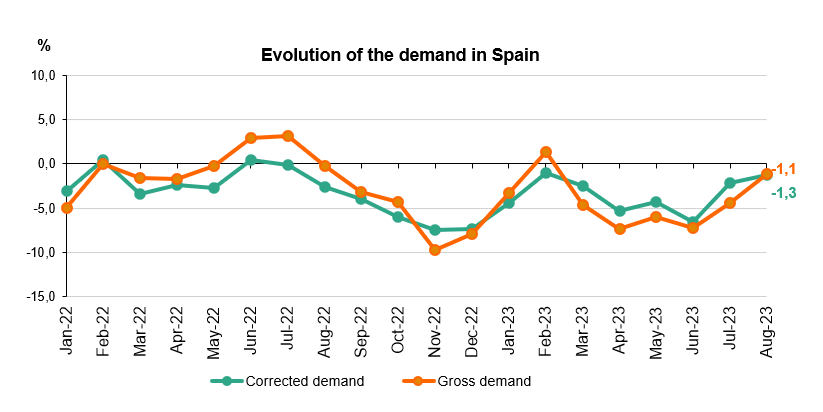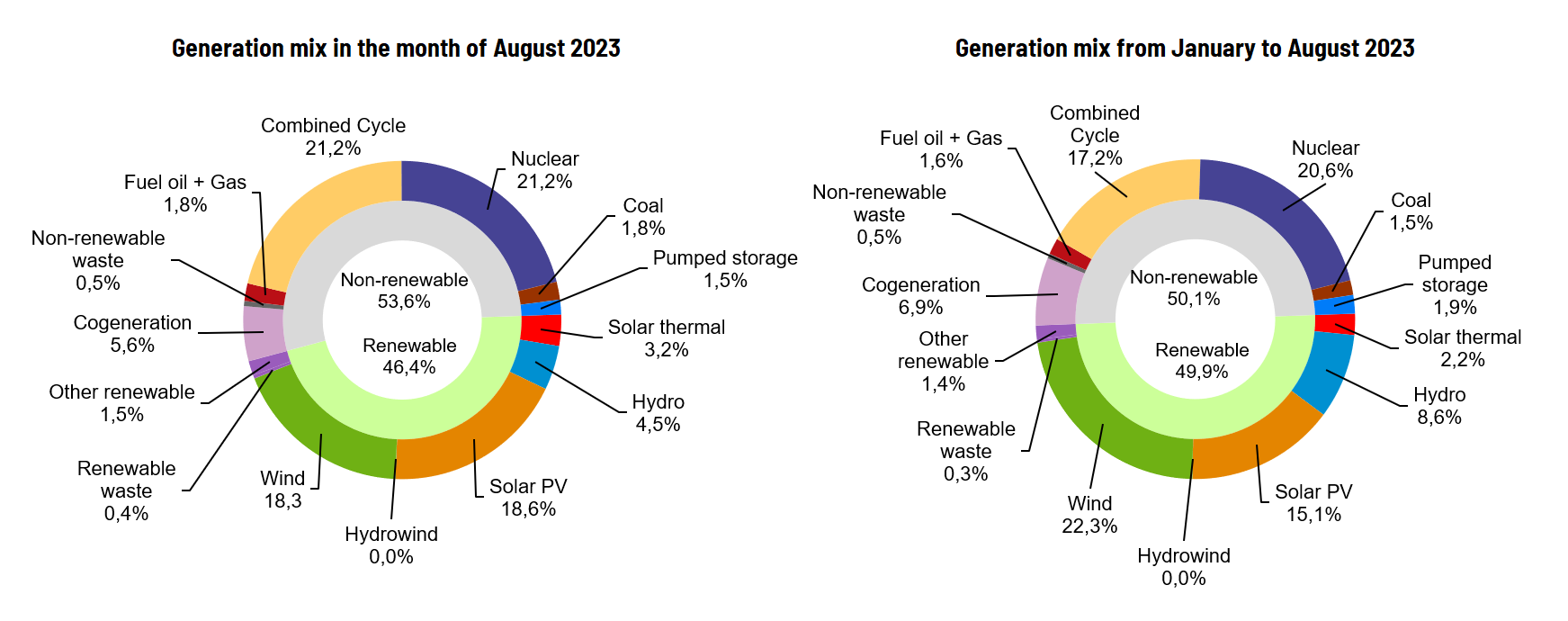Discover what Red Eléctrica is, what we do, and why we are the backbone of the electricity system in Spain and the ecological transition.
Demand for electricity in Spain falls 1.3% in August
- Wednesday 19 July saw the highest daily demand so far this year with nearly 841 GWh.
- 46.2% of electricity production was renewable and 68.5% was obtained using zero-carbon energy technologies.
- Solar photovoltaic increased its production by 32.9% compared to the same month in 2022. This is the highest monthly production since records began - 4,507 GWh -. Solar photovoltaic also registered the highest monthly coverage: 18.93% of the generation mix.
National electricity demand in August showed a 1.3% decrease year-on-year after having factored in the influence of seasonal and working patterns. In gross terms, demand is estimated at 21,765 GWh, down 1.1% on August 2022.

In the year to date, Spain has registered a cumulative demand of 164,232 GWh, down 4.1% on the same period in 2022. Once again, after having factored in the influence of seasonal and working patterns, demand fell by 3.5% year-on-year.
In August, renewables generated 14.8% more electricity than in the same month in 2022, accounting for 10,965 GWh, which represents a share of 46.4% of the total production, according to data available at the time of this press release. Also noteworthy is that 68.6% of the month's electricity production was obtained using zero-carbon energy technologies.
In the first eight months of 2023, renewable energy generation grew by 13.8% compared to the same period last year.
In August, solar photovoltaic energy registered a production of 4,389 GWh, up 35.3% on the same month of 2022. Its contribution to the national generation mix represented a share of 18.6%, making it the leading source of renewable generation in Spain for the third consecutive month.
Wind power generation in August totalled 4,325 GWh and accounted for 18.3% of the total production, maintaining its position as the leading technology for the year with a 22.3% share in the generation mix.
Hydroelectric generation increased its output by 9.6% year-on-year and totalled 1,065 GWh, representing an overall share of 4.5% in Spain’s generation mix.

Demand for electricity in the peninsular system
Regarding the mainland electricity system, and after having factored in the influence of seasonal and working patterns, demand for electrical energy in August was 1.4% lower than the same month in 2022. In gross terms, demand stood at 20,199 GWh, down 1.4% year-on-year.
In the first eight months of the year, electricity demand on the Spanish mainland stood at 154,075 GWh, a 4.3% decrease compared to 2022. Again, after having factored in the influence of seasonal and working patterns, demand fell by 3.6%.
Renewables as a whole generated 48% of the peninsular total and 71.7% of the electricity produced was obtained using zero-carbon energy technologies.
In August, noteworthy was the share of solar photovoltaic energy on the Spanish mainland, ranking in third place in the generation mix, with a 19.4% share of the overall mix of all technologies, and accounted for a total of 4,312 GWh.
Electricity demand in the Balearic Islands and the Canary Islands
Electricity demand in the Balearic Islands in August, after having factored in the influence of seasonal and working patterns, was 5.5% lower than in the same month in 2022. Thus, gross monthly demand is estimated at 708,974 MWh, down 2.7% on that registered in August 2022. In the first eight months of 2023, gross demand in the Balearic Islands is estimated at 4,144,809 MWh, down 1.8% year-on-year.
In terms of generation, combined cycle, accounted for 63.8% of the energy produced in the Balearic Islands and was the leading energy source in the islands in August. For its part, renewable energy obtained using zero-carbon energy technologies in the Balearic Islands represented 11% of the total. In addition, this month, the subsea link between the mainland and Majorca contributed to covering 24.6% of the electricity demand in the Balearic Islands.
For its part, and after having factored in the influence of seasonal and working patterns, electricity demand in the Canary Islands increased by 6.2% year-on-year. In gross terms, demand stood at 816,547 MWh, up 7.8% year-on-year. So far this year, cumulative demand in the Canary Islands is estimated at 5,748,620 MWh, up 1.7% compared to the same period in 2022.
In terms of electricity generation in the Canary Islands, combined cycle, with 39.4% of the total, was also the leading technology in August, whilst renewables and generation obtained using zero-carbon energy technologies accounted for 26.8% of the total production on the islands this month, with wind generating 22.3% of the total.
Consult our Daily Balance Report for more information on the National, Peninsular, Balearic Islands and Canary Islands electricity systems as at the close of August.
Downloads











